Second Generation QD-OLED Panels from Samsung, Improvements and Changes for 2023
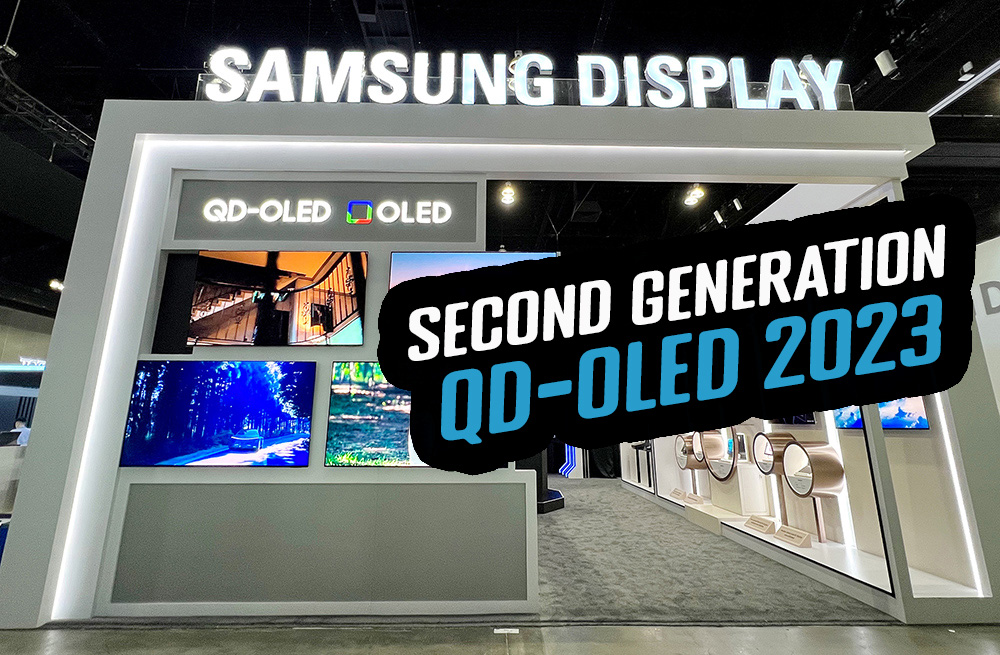
Introduction
Samsung have been talking a fair bit about their second-generation QD-OLED (Quantum Dot OLED) technology this year, and we thought it would be useful to give a run-down of the improvements they are promoting, and changes we might expect to see with forthcoming QD-OLED panels. Samsung produce QD-OLED panels in the TV and monitor space, but we are most interested here in the monitor panels. We will give a run-down of the panels available now, soon or planned for the future, along with some expectations around possible performance changes and improvements. Some of this remains to be tested and verified, and as ever take some of the marketing claims from Samsung with a pinch of salt as they are of course keen to promote their technology as the best out there.
What is QD-OLED?

In case you aren’t familiar with QD-OLED (Quantum Dot OLED) we will give a brief overview before we get in to the rest of the article. This is Samsung’s own OLED (Organic Light Emitting Diode) technology, a direct competition to the widespread “WOLED” (White+OLED) that is manufactured by LG.Display and has had the monopoly until now in the OLED TV market. Samsung’s QD-OLED tech is so-called because they use a Blue OLED light source, and add a Red and Green Quantum Dot layer to produce the expected Red, Green, Blue (RGB) output. It’s a self-emissive technology, just like LG.Display’s equivalent, and so still offers the familiar benefits of this panel technology. Those include near-instant super fast response times, per pixel level dimming for exceptional HDR performance, and the ability to turn each pixel off individually which gives you true blacks and a basically infinite contrast ratio.
How QD-OLED is different to WOLED
Obviously Samsung will want to promote how their technology is better than LG’s, and visa versa. Each is pretty quick to highlight the supposed flaws in the other technology, but we can still consider how the two are different technologically without getting dragged in to that fight. There’s plenty of praise for QD-OLED in the market though and it’s been very well received since it’s introduction.

LG.Display’s WOLED technology uses the normal Red, Green and Blue sub-pixels, but adds an additional fourth white sub-pixel which is used to help increase brightness. The light source comes from a white OLED layer. This has been the standard for OLED panels for many years, and LG’s technology has really been the only choice across a range of different OLED TV manufacturers for a long time. We should point out that the pixel layout of their WOLED panels is actually Blue, White, Green, Red (BWGR) and so this leads to some text clarity issues and fringing from PC’s as it’s a non-traditional layout that currently isn’t expected or understood by Windows or their ClearType tool. We talked a lot more about the text rending problems for OLED panels in our video here. Samsung’s QD-OLED isn’t exempt from text rendering problems either by the way but it’s for a different reason.
Samsung’s QD-OLED technology on the other hand uses a “truly additive” approach as they put it, with Red, Green and Blue sub-pixels. As we discussed above this is achieved through conversion of a Blue OLED light layer with Red and Green Quantum Dots applied for the other colours. There’s no need for the additional white sub-pixel, something Samsung are of course keen to suggest is a game-changer (and which we are sure LG would counter with their own arguments). While the sub-pixels are in a standard Red, Green, Blue (RGB) layout, they are in an unusual triangular pattern which again causes some challenges with text clarity from PC’s. Some more discussion about sub-pixel layout and some possible improvements later on in this article.

Samsung claim that their colour conversion approach is superior and providers more vivid and accurate colours, and also wider viewing angles. This is achieved they say thanks to the narrower and taller spectral characteristics of their panels (colours), as well as the Quantum Dot layer being on the top without a polarizer (viewing angles(. Above you can see an example spectral distribution when displaying white light comparing QD-OLED to WOLED and these look quite different. Samsung say this helps with “minimal adjacent colour contamination across the luminance range”. We can also verify the spectral distribution ourselves by comparing two monitors we’ve tested:

So the spectral distributions are certainly different between the two technologies. Whether or not this really leads to significant improvements needs further investigation although QD-OLED panels are well regarded for their colour capabilities. But then there are lots of things in play here like colour gamut, colour volume, luminance range etc. For now we can at least confirm this is a technological difference between the two competing panel types.
Promoted QD-OLED Benefits

Samsung are keen to market QD-OLED in the below ways. Much of this will require further testing and experimentation, and we’ve tried to avoid as much as possible falling in to their marketing trap. We will provide details and commentary on their claimed benefits and capabilities below, and look to validate and test some of these claims in the future as we review more OLED displays.
- Wide colour gamut – with the ability to cover up to 99% DCI-P3 (why not 100%?!) and 90% BT.2020
- Near instant response times and top end motion clarity – this is a feature of all OLED panels and helps with motion clarity, as well as making higher refresh rates viable. The fast response times combined with the latest high refresh rates of 240Hz+ will also help these panels meet the criteria for VESA’s ClearMR 13000 tier, currently the top of their range. Looking at VESA’s list of certified products we can see that last year’s 175Hz QD-OLED panels are certified to ClearMR 9000, whereas current 240Hz OLED displays (albeit using LG.Display’s WOLED panels) reach ClearMR 13000. The new 240Hz QD-OLED panels from Samsung should achieve the same. You can see testing of OLED response times and motion clarity in our current OLED monitor reviews.
- Excellent colour performance at all brightness levels – this is an element Samsung highlight as a benefit relative to LG’s WOLED technology. They say that with WOLED you need to increase the proportion of white light to help reach higher peak brightness levels, something enabled by the extra white sub-pixel. In doing so, they claim that as you reach higher brightness you get some “washout” of colours where the saturation of pure colours decreases because of that “white boost”. This is a claim we’d need to investigate more as further QD-OLED and WOLED monitors are released to market.
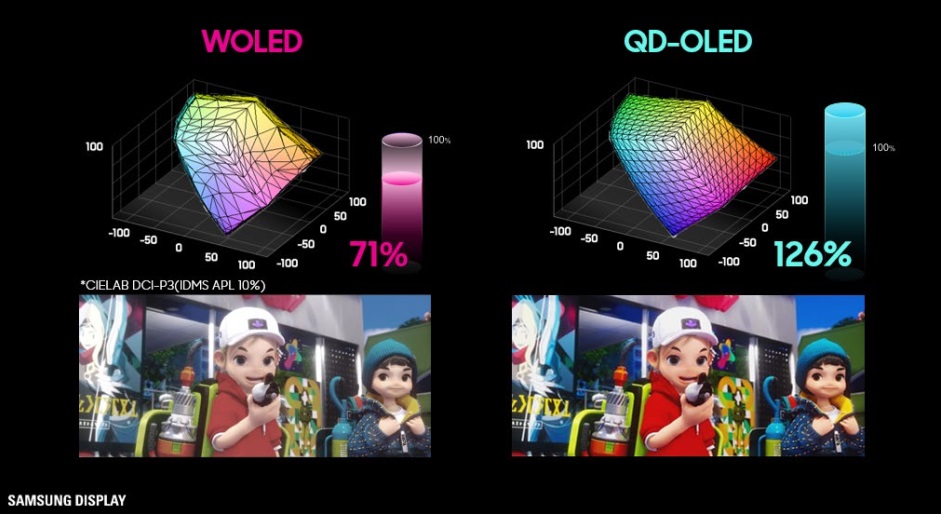
- Wide colour volume – they claim that QD-OLED can also offer very high colour volume, accounting for colour performance across a luminance range, which is a measure more suited to today’s modern HDR displays. They say that “capability to exhibit accurate colors in a wider luminance range is critical to support this growing desire and demand to experience real HDR…QD-OLED expands the 3D color volume capabilities compared to other technologies”. Samsung go on to explain that “to compensate for its limited brightness, WOLED employs a white subpixel to increase brightness. The color volume capacity reduces as the white light output increases. Volumetric collapse occurs, particularly for the brighter hues. In contrast, QD-OLED, which expresses color only using R, G, and B, can replicate color across the luminosity range. So, while they may have a similar 2D color gamut or a similar peak luminance, their true color reproduction performance is a generation apart! The visual experience on the QD-OLED is also significantly more refined and realistic.” Again further investigation is needed to validate these claims, but there’s some further detail provided by Samsung on the topic here.
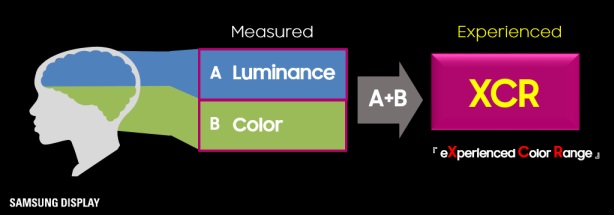
- Better “Experienced Color Range (XCR)” – another claim from Samsung is that the improved colour range provided by QD-OLED compared with WOLED leads to a perceived higher brightness by the user, even where actual measured luminance may be the same. They call this the Experienced Color Range (XCR) and suggest this leads to brighter, more life-like images. Further direction comparisons are again needed here in the future. A lot more detailed information about XCR is available here on Samsung’s website.
- Excellent shadow detail and dynamic range – OLED’s are well known for offering true blacks and amazing contrast, along with the per pixel level dimming to avoid halos and blooming that you get on LCD screens. Samsung claim their handling of near-black shadow detail is better than WOLED because they don’t need to use the white sub-pixel and can offer higher colour luminance. The removal of the white sub-pixel can help avoid “near-black “low luminance chroma overshoot” which is talked about in this video from HDTVtest. Again this will need further testing and validation, but Samsung do provide some further information here on the topic. Note that issues with panel coating and perceived contrast may also come in to play here though, discussed more below.

- Very wide viewing angles and off-axis viewing performance – Samsung claim that their technology offers even wider viewing angles than WOLED. They say that “QD-OLED are Top-Emmision displays. The QD-OLED light energy is dome shaped or ‘lambertian’, in simple words it is evenly distributed which results is perfect color and luminance no matter the viewing angle”. This actually has some drawbacks, which funnily enough they don’t talk about, when it comes to perceived contrast ratio and black depth in certain situations. We will talk about that in a bit. To put a figure on it, Samsung claim “QD-OLED retains 34% more brightness and 50% less color shift even at a significant off-axis viewing angle, such as 60 degrees” [compared with WOLED].
Current and Planned QD-OLED Monitor Panels

Last year Samsung’s first monitor-sized panel was adopted by several manufacturers and available in a 34″ ultrawide form-factor, 3440 x 1440 resolution and with a 175Hz refresh rate. We reviewed the first of these to market at the time which was Dell’s Alienware AW3423DW. Other similar models based on the same panel have subsequently been released or announced by the likes of Samsung, MSI and Philips for instance.
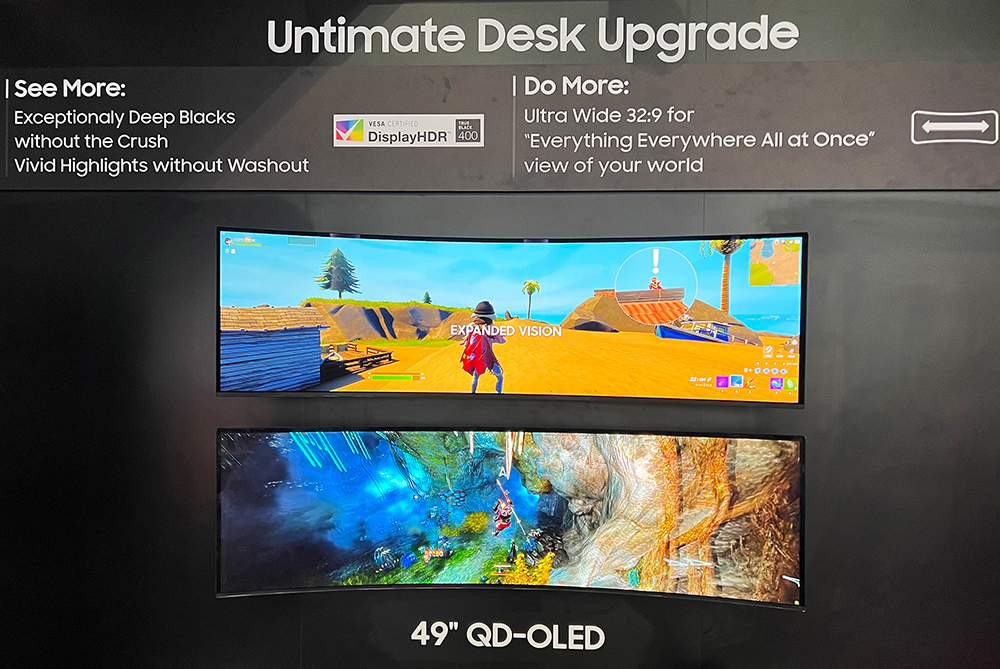
We have yet to see any other sized panels released, although a couple of 49″ super ultrawide offerings are due later this year, and will be used in displays like the Samsung Odyssey OLED G9 and MSI 491C for instance where they offer 5120 x 1440 resolution and 240Hz, and in displays like the Asus ROG Swift PG49WCD which will have the same resolution but a lower 144Hz refresh rate. This lower refresh rate panel could also support lower display pricing, but time will tell.
We also know from our recent OLED roadmap article that Samsung plan to develop other panel options at some point in 27″, 31.5″ and 34″ sizes with 240Hz and even 360Hz refresh rates, but timescales for these are not yet known. With the new 49″ panels emerging though this year, we will start to see some of their second-generation technology utilised, and hopefully some further improvements to the panels.
QD-OLED 2023 Second-generation Panel Updates
According to the information provided by Samsung, their 2023 second-generation innovations are as below. Samsung like most tech companies are never ashamed to introduce a fancy/random new name and/or acronym. We’re just glad they’ve not used the word “Quantum” endlessly as they seem to have become obsessed with in recent years!

HyperEfficient EL – helping to increase panel brightness
The second generation 2023 QD-OLED panels will be developed with a “breakthrough new OLED Hyper-Efficient Electroluminescence material“. This makes its blue-emitting later more efficient and clearer and leads to an expected brightness increase of 30% for brighter highlights. They talk in their press releases about the new panels being able to achieve >2000 nits, although this will likely be lower once calibrated to a D65 white point. Still, increased brightness is certainly a positive.
Keep in mind this brightness improvement may only be applicable for the larger TV panels for which they have 77″, 65″ and 55″ panels planned. In the monitor space there are trade-offs between driving higher brightness in such a small screen size, and panel life-span. We may start to see higher peak brightness in the QD-OLED monitor market in the future, but for now the specs of the announced displays, including the forthcoming 49″ super ultrawide panels we talked about above that are based on second gen panels, are still listing 1000 nits as the peak HDR brightness. The new HyperEfficient EL material used in the second gen panels can allow higher peak brightness, but it remains to be seen if and how this is adopted in the monitor market and if manufacturers will push this higher on smaller displays.
Samsung are also keen to point out that any increase in brightness achieved with their technology is “full brightness”, i.e. brighter white AND colour, and not just a “white boost” like might be the only solution from competing technologies like WOLED. This they say ensures better colour performance and more vivid images at those higher brightness levels.

Samsung also say that the increased brightness of their second gen panels will allow them to meet the criteria for VESA’s DisplayHDR True Black 500 tier, whereas 2022 panels would generally only meet True Black 400. Although oddly none of the current 34″ QD-OLED monitors appear to have been certified officially under even the TB400 scheme according to VESA’s list of certified products. At the end of the day, the new panels are expected to offer higher brightness capabilities and so should hopefully meet the TB500 tier.
IntelliSense AI – helping to potentially increase life span and reliability
The second generation panels will also feature Samsung’s “most advanced pixel level optimization algorithm, IntelliSense AI (v2.0)”. This apparently offers “real-time monitoring [that] predicts and optimizes pixel level load and light output for each sub-pixel. This means any abnormal behavior is detected and resolved instantly, like magic!” This will apparently help improve panel lifespan and reliability, as well as screen uniformity over time. Samsung even go as far as to say these newer generation panels will offer twice the durability of last year’s first generation. It also reduces overall power consumption by up to 25% compared to last year’s panels.

Life span concerns need further validation and analysis
Let’s talk quickly about life-span a bit more. There’s been noise in the market, including from LG.Display themselves, that perhaps QD-OLED panels have a shorter lifespan than WOLED, and show a higher risk of burn in over time. This seems to be based on stress testing carried out by Rtings.com (ongoing) for which we have provided our thoughts and commentary here. Further updates are expected from Rtings in the coming months, so we will update that article as and when there are more conclusions or more insight but for now we don’t believe it is fair to jump to those conclusions at this time.
Updated pixel structure may help with text rendering
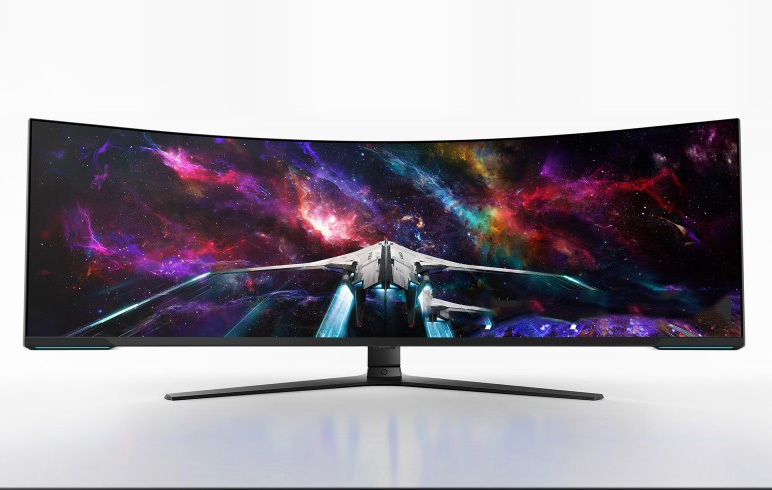
One potentially positive improvement for monitor usage that isn’t talked about or promoted on Samsung’s website is an apparent improvement to the pixel structure. YouTube channel “Little Snowman Evaluation” (we hope we have that translation right!) have done some testing and measurements of an early prototype of the Samsung Odyssey OLED G9 (our news piece), one of the new monitors using Samsung’s new 49″ QD-OLED panel from their 2023 second generation.

They observed a change to the pixel structure from a hexagonal shape to a more square shape as shown in the magnified photo above. They are still arranged in the same RGB triangular layout as before, but the video states that thanks to the change there have been some improvements to text clarity in their opinion, and (as the translated closed captions put it) “to a certain extent, the phenomenon of font glitches has been reduced”. We look forward to testing this ourselves as we get hold of 2023 QD-OLED monitors later this year.

Perceived contrast challenges due to panel structure

We wanted to touch on this topic here as it seemed a logical place to discuss this widely discussed, but generally poorly understood area. One topic that Samsung obviously don’t talk about much is the dulling of black depth and contrast ratio experienced on QD-OLED panels, and indeed many OLED panel, when viewed in a moderately or well lit room. All OLED panels can offer true blacks and basically infinite contrast ratio, but are designed to be viewed ideally in a dark room with very minimal or no ambient light. When many OLED screens are viewed in brighter lighting conditions, the contrast can be impacted and blacks start to look more dark grey. Those using OLED displays in the day time, or in well lit rooms have been concerned about this effect.

This has been a particular problem on QD-OLED panels than it has on WOLED, and to date has been largely put down (incorrectly) to the semi-glossy Anti-Reflective (AR) screen coating that these panels feature. It’s not a fully glossy solution, nor is it a matte coating, it’s a strange hybrid that can’t really decide what it wants to be. Actually, what is causing this drop in perceived contrast ratio on QD-OLED panels is more caused by the fact that the Quantum Dot layer is on the top, without there being any polarizer, and the ambient light inadvertently gets refracted back to the viewer as a result by this layer. Samsung opted to put the QD layer on the top to improve brightness and viewing angles which they are keen to highlight, but an unwanted side effect is unfortunately this enhanced dulling of contrast relative to WOLED.
On WOLED panels the use of a matte Anti-Glare screen coating can cause some light refraction compared with a glossy coating as we;;, but this is still to a lesser extent than what you see on QD-OLED panels. To clarify, it’s primarily the QD layer and the lack of a polarizer on the QD-OLED that really causes this phenomenon. Samsung claimed at CES 2023 in this interview with AVForums that they’ve made some tweaks to their AR coating (now in it’s 5th generation), although whether or not it’s made a significant improvement in their QD-OLED TV panels is still unclear. We also don’t know if there will be any improvements in the monitor panel space, so it will be interesting to properly test the 49″ ultrawide panels when they arrive later this year. This paper discusses the topic a bit more as well.
At the moment this issue makes QD-OLED a little less suitable than WOLED for monitor usage for users where contrast and black depth are a focus, or where they know they are likely to use the screen in more well-lit conditions. The mid-way Anti Reflective coating is also not to everyone’s taste, although the same could be said for Anti-glare matte coatings currently used by WOLED panels. We look forward to testing second-gen panels later this year.
- Related content: The OLED Black Depth Lie – When Panel Type and Coating Matters
Conclusion
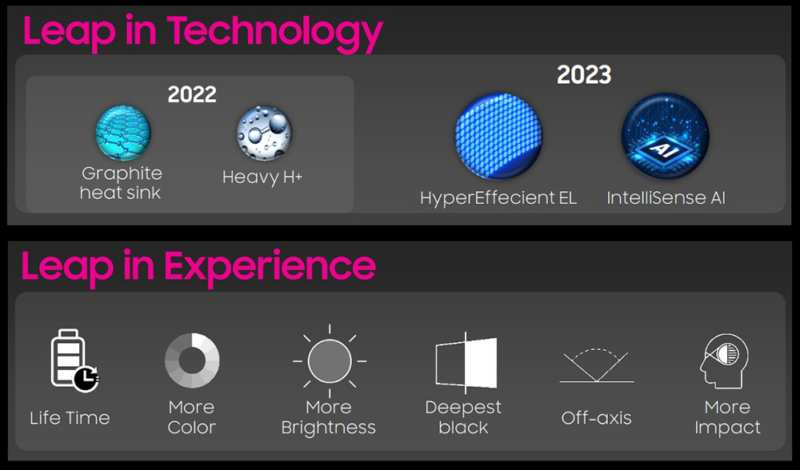
It’s great to see continued investment and focus from Samsung in their QD-OLED technology, and it certainly offers some very strong performance for TV’s and monitors. We are also pleased to see some improvements being made to the panels in their second generation in 2023, although it’s not clear how much of those will translate to real-world changes in the monitor space. Increases to brightness are likely to apply more to larger TV panels, but it still gives us hope that monitor-sized panels can be improved in this area in the future too even if current specs suggest no change. Additional measures to help extend durability and lifespan are of course welcome too, and we look forward to further stress testing and analysis from Rtings on this topic in the future. It also seems that there may be another positive change that isn’t really discussed by Samsung, and that is the change to the pixel structure which may offer some improvements to text rendering on their monitor panels. The early signs are positive there and will no doubt be welcome by those wanting to use their screen for desktop uses.
This is of course a very Samsung-heavy article and we’ve tried our best to avoid following marketing claims mindlessly, and instead tried to provide some commentary, context and thoughts on the claims Samsung make. We’ve also tried to balance some of this with counter arguments, and by highlighting some areas that are not so great with this technology. If LG.Display are reading this article and would like to discuss their WOLED technology or provide further information that might give their side of the story or allow us to write more detailed articles about their panels, please do get in touch.
Related content and further reading:
- Samsung’s 2023 QD-OLED website
- Our review: Dell Alienware AW3423DW QD-OLED
- Our video: Before You Buy an OLED Monitor – 5 Things You Need to Know
Update for Gen 3 2024
Update 8 January 2024, For information on Samsung’s QD-OLED plans for their 2024 gen 3, see the video below:
We may earn a commission if you purchase from our affiliate links in this article- TFTCentral is a participant in the Amazon Services LLC Associates Programme, an affiliate advertising programme designed to provide a means for sites to earn advertising fees by advertising and linking to Amazon.com, Amazon.co.uk, Amazon.de, Amazon.ca and other Amazon stores worldwide. We also participate in a similar scheme for Overclockers.co.uk, Newegg, Bestbuy , B&H and some manufacturers.
Stay Up To Date
 |  |  |  |
| Browser Alerts | Follow on X | Subscribe on YouTube | Support Us |
Popular Trending Articles
 4th Gen Primary RGB Tandem OLED Monitors Are Here! – Gigabyte MO27Q28G Showcase August 22, 2025 Explaining 4th Gen Primary RGB Tandem WOLED and it’s benefits and specs. Including a showcase of the Gigabyte MO27Q28G monitor
4th Gen Primary RGB Tandem OLED Monitors Are Here! – Gigabyte MO27Q28G Showcase August 22, 2025 Explaining 4th Gen Primary RGB Tandem WOLED and it’s benefits and specs. Including a showcase of the Gigabyte MO27Q28G monitor Here’s Why You Should Only Enable HDR Mode on Your PC When You Are Viewing HDR Content May 31, 2023 Looking at a common area of confusion and the problems with SDR, desktop and normal content when running in HDR mode all the time
Here’s Why You Should Only Enable HDR Mode on Your PC When You Are Viewing HDR Content May 31, 2023 Looking at a common area of confusion and the problems with SDR, desktop and normal content when running in HDR mode all the time Gen 4 Samsung QD-OLED 2025 Panels and Improvements April 14, 2025 A complete look at Samsung Display’s latest QD-OLED updates and news for 2025 including new technologies, improvements and specs
Gen 4 Samsung QD-OLED 2025 Panels and Improvements April 14, 2025 A complete look at Samsung Display’s latest QD-OLED updates and news for 2025 including new technologies, improvements and specs![[Update 2] Testing 'HDR400 True Black' and 'Peak 1000' Mode Brightness on New OLED Monitors banner3](https://tftcentral.co.uk/wp-content/uploads/2024/03/banner3-130x90.jpg) [Update 2] Testing ‘HDR400 True Black’ and ‘Peak 1000’ Mode Brightness on New OLED Monitors April 27, 2024 Testing the common HDR modes on new OLED monitors to figure out which mode is brighter for HDR and for SDR content
[Update 2] Testing ‘HDR400 True Black’ and ‘Peak 1000’ Mode Brightness on New OLED Monitors April 27, 2024 Testing the common HDR modes on new OLED monitors to figure out which mode is brighter for HDR and for SDR content QD-OLED Generations Infographic and FAQ June 17, 2025 A handy infographic explaining all QD-OLED panel generations along with answers to frequently asked questions
QD-OLED Generations Infographic and FAQ June 17, 2025 A handy infographic explaining all QD-OLED panel generations along with answers to frequently asked questions
